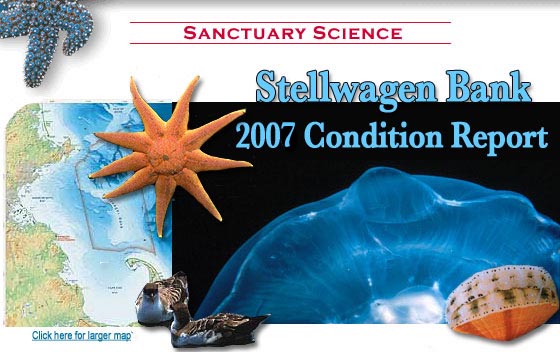Error processing SSI file
Responses to Pressures in Stellwagen Bank Sanctuary
This section describes current or proposed responses to pressures. Current responses are based on implementation of the sanctuary's 1993 management plan. Proposed responses are those strategies outlined in the draft management plan developed in conjunction with the sanctuary's advisory council, a 15-member citizen advisory body. The draft plan is scheduled for release in the summer of 2007. Some recommendations are already being acted on by the sanctuary, such as moving the Boston shipping lanes to better protect endangered whales.
Ecosystem-Based Management
As the sanctuary is not an ecosystem unto itself but rather part of the much larger Gulf of Maine ecosystem, the application of ecosystem-based management to Stellwagen Bank can be approached along two parallel tracks. First, the application of ecosystem-based management in the sanctuary will involve collaboration with other regional agencies charged with managing components of the ecosystem beyond the sanctuary boundaries. Second, for management within sanctuary boundaries, a subset of the larger ecosystem can be determined by defining components unique to Stellwagen Bank, and identifying characteristics of the larger ecosystem that influence the sanctuary.
Even though NOAA's National Marine Fisheries Service is in the process of implementing ecosystem-based management principles for the management of the nation's fisheries, there are no ecosystem-based management plans in the southern Gulf of Maine at this time. The sanctuary currently regulates the mining of sand and gravel, disturbance of the seafloor (with the exception of fishing activity), and dumping of waste material within its boundaries. Fisheries management in the Federal waters of the region is conducted on a species by species basis. Similarly, even though NOAA's National Marine Fisheries Service's Atlantic Large Whale Take Reduction Team has grouped a number of large cetaceans under its auspices, the Marine Mammal Protection Act is enforced on a species-by-species basis.
The sanctuary advisory council has come to consensus on the following definition and goal of ecosystem-based management for Stellwagen Bank:
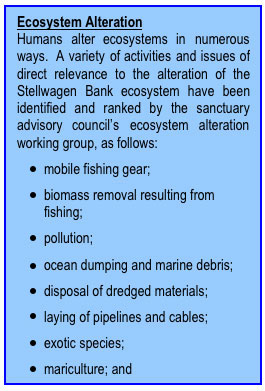 "Ecosystem-Based Management [in the Stellwagen Bank sanctuary] integrates knowledge of ecological interrelationships to manage impacts within sanctuary boundaries. The general goal of ecosystem-based management is to protect the ecological integrity of [Stellwagen Bank] while recognizing that the sanctuary is nested within the Gulf of Maine's large marine ecosystem. Effective implementation of ecosystem-based management should: (1) consider ecological processes that operate both inside and outside sanctuary boundaries, (2) recognize the importance of species and habitat diversity, and (3) accommodate human uses and associated benefits within the context of conservation requirements." "Ecosystem-Based Management [in the Stellwagen Bank sanctuary] integrates knowledge of ecological interrelationships to manage impacts within sanctuary boundaries. The general goal of ecosystem-based management is to protect the ecological integrity of [Stellwagen Bank] while recognizing that the sanctuary is nested within the Gulf of Maine's large marine ecosystem. Effective implementation of ecosystem-based management should: (1) consider ecological processes that operate both inside and outside sanctuary boundaries, (2) recognize the importance of species and habitat diversity, and (3) accommodate human uses and associated benefits within the context of conservation requirements."
In an effort to begin the implementation of ecosystem-based management, the sanctuary advisory council also recommends the following research and management strategies:
- Understand ecosystem structure and function
- Protect ecological integrity
- Evaluate the need and feasibility for modifying the sanctuary boundary
- Establish a research steering committee
- Establish a collaborative research consortium
- Establish an information management program
National marine sanctuaries have long been places that prohibit discharges within their boundaries. Every sanctuary has been designated with the authority to develop some form of discharge regulation to protect its natural and cultural resources. For example, most national marine sanctuaries prohibit the discharge of garbage, trash, and plastics, and oily wastes from bilge pumping. However, most sanctuaries have specific exemptions to their discharge prohibition.
Regulations for Stellwagen Bank sanctuary specifically prohibit:
- Discharging or depositing, from within the boundary of the sanctuary, any material or other matter except:
- fish, fish wastes, chumming materials or bait used in or resulting from traditional fishing operations in the sanctuary;
- biodegradable effluent incidental to vessel use and generated by marine sanitation devices approved in accordance with the Federal Water Pollution Control Act;
- water generated by routine vessel operations (e.g., cooling water, deck wash down and graywater as defined by the Federal Water Pollution Control Act), excluding oily wastes from bilge pumping; or
- engine exhaust.
- Discharging or depositing, from beyond the boundary of the sanctuary, any material or other matter except those listed above, that subsequently enters the sanctuary and injures a sanctuary resource or quality;
- Lightering in the sanctuary (transferring cargo, usually oil, between vessels).
In many areas more research must be undertaken before it can be determined whether certain waste streams present potential human and/or environmental threats. In other areas, it was decided that partnerships with outside monitoring, modeling and research efforts may provide the technical resources needed by the sanctuary for a better understanding of water quality at the site. Sanctuary staff have determined that at this time, the focus on water quality will be divided into two initiatives, both of which will be proposed in the Stellwagen Bank draft management plan and implemented within the next five years.
Water Quality Monitoring
The Massachusetts Water Resources Authority initiated a water quality monitoring program in 1992 with some sampling sites occurring within sanctuary boundaries. In 2001, the sanctuary augmented the two MWRA sites with four additional sites sampled twice annually.
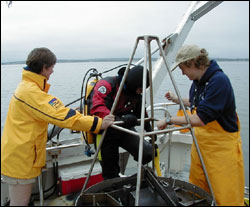 |
| Scientists from the Marine Biological Laboratory in Woods Hole monitor sediment metabolism for the Massachusetts Water Resources Authority. (Photo: Woods Hole Oceanographic Institution)
|
|
|
Together, these initiatives include a water quality monitoring, modeling and assessment program for Stellwagen Bank that assures the goals of protecting natural and cultural resources and human health. The draft management plan includes development of a comprehensive water quality monitoring program, implementation of an ocean observing system, and evaluation and use of water quality models for sanctuary management. The water quality monitoring plan will evaluate the inclusion of sediment monitoring, recognizing that contaminants in sediments contribute to the quality of the overlying water and the health of living resources.
Vessel Discharges and Other Waste Streams
This initiative will implement strategies to prevent impacts to sanctuary resources from discharges from vessels, sewage outfalls, and other waste streams. The emerging plans include discussion of the designation of a no discharge zone for the sanctuary and development of a ballast water management strategy. Furthermore, strategies for addressing contingency planning for oil or other hazardous material spills as well as responses to catastrophic failures or other pollution events from sewage effluents and disposal activities are also being developed. There is a strong emphasis on interagency cooperation and responsibility.
To effectively address pressures on the integrity of the sanctuary habitat, it is necessary to observe the sanctuary's marine ecosystem in its entirety. Elements of the marine ecosystem are closely associated with one another, and an understanding of these relationships can assist in determining the overall health of the environment. For example, there is a high degree of correlation between habitat and biological recovery rates. That is, if habitat is severely disturbed such that it causes a noticeable reduction in a fish species, the recovery rate of the species is likely to be highly correlated with the recovery rate of the associated habitat. Correlations between these living and nonliving resources provide methods of measuring the health of the sanctuary habitat.
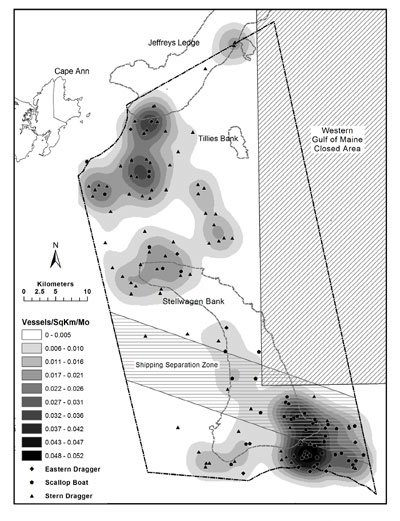 |
| Distribution and relative density of bottom-tending trawler fishing effort in the sanctuary, 2001-2002. Click here for larger view. (Source: Wiley et al. 2003)
|
|
|
Currently, regulations pertaining to Stellwagen Bank sanctuary prohibit drilling into, dredging or otherwise altering the seabed of the sanctuary; or constructing, placing or abandoning any structure or material or other matter on the seabed of the sanctuary, except as an incidental result of (1) anchoring vessels; (2) traditional fishing operations; or (3) installation of navigation aids.
Substantial regulations promulgated by NOAA's National Marine Fisheries Service and state agencies also govern fishing effort in the Northeast, including Stellwagen Bank. Some directly or indirectly affect the impact of mobile gear on benthic habitats, particularly in areas considered to be essential fish habitat. The regulations direct the New England Fishery Management Council and NOAA's National Marine Fisheries Service to: (1) describe and identify essential fish habitat in each fishery management plan, (2) minimize to the extent practicable the adverse effects of fishing on essential fish habitat, and (3) identify other actions to encourage the conservation and enhancement of essential fish habitat. These regulations apply to Stellwagen Bank sanctuary, but the sanctuary does not have the independent ability to modify or maintain those regulations.
Although numerous regulations exist to protect the Stellwagen Bank habitat, several concerns remain, as indicated in the list above. Six in particular are receiving current attention: (1) alteration of benthic habitat due to commercial fishing activities; (2) the potential issuance of permits to lay cables and pipelines within sanctuary boundaries: (3) ocean dumping; (4) discharge of dredge spoil; (5) lack of an undisturbed reference area; and (6) the potential for mariculture activities.
To address these issues, the sanctuary advisory council has recommended the development of plans to:
- Focus on the ecosystem impacts of the laying of cables and pipelines within the sanctuary.
Reduce the alteration of benthic habitat by mobile fishing gears.
Reduce the ecosystem impacts of biomass removal by fishing activity.
Focus on the ecosystem impacts of ocean dumping, the disposal of dredged materials and mariculture.
The sanctuary advisory council has convened a working group to consider zoning as a means to restore and protect the ecological integrity of the sanctuary.
Fishing regulations in Stellwagen Bank, promulgated by various fishery management agencies, focus on managing exploitation of particular taxa and not necessarily on conservation of biological diversity overall. 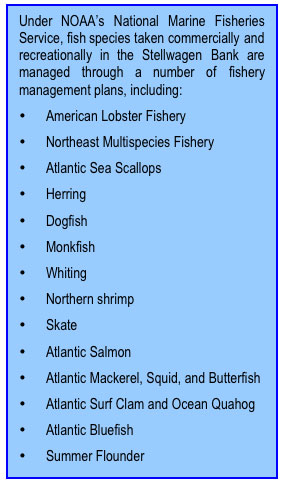 Besides the National Marine Sanctuaries Act, currently only the Endangered Species Act deals with the protection of taxa not linked to fishing. Of the 3,317 species in the Gulf of Maine region (COML 2006), there are only 41 species that are managed by the regional fishery management councils (as well as tunas, sharks, swordfish, and billfish groups that are managed separately as highly migratory species) and 12 species managed under the Endangered Species Act. This leaves the majority of biodiversity in the Stellwagen Bank sanctuary with little or no management or protection unless a new fishery develops or it is found that populations have declined to the extent that they are somehow endangered. Besides the National Marine Sanctuaries Act, currently only the Endangered Species Act deals with the protection of taxa not linked to fishing. Of the 3,317 species in the Gulf of Maine region (COML 2006), there are only 41 species that are managed by the regional fishery management councils (as well as tunas, sharks, swordfish, and billfish groups that are managed separately as highly migratory species) and 12 species managed under the Endangered Species Act. This leaves the majority of biodiversity in the Stellwagen Bank sanctuary with little or no management or protection unless a new fishery develops or it is found that populations have declined to the extent that they are somehow endangered.
Fishery resources in the Northeast, including in the sanctuary, are regulated by NOAA's National Marine Fisheries Service with input from the New England and Mid-Atlantic Fishery Management Councils and the Atlantic States Marine Fisheries Commission. Some restrictions on fishing that affect the sanctuary have been put in place, including rolling closures for groundfishing, catch limits for individual species, and a large, permanent year-round habitat closure in the Western Gulf of Maine. Although NOAA National Marine Fisheries Service is the primary regulatory authority for fishing, the National Marine Sanctuaries Act provides a mechanism for interagency consultation allowing the sanctuary to have input on the fishing regulations that may affect its resources. Periodic reviews of a sanctuary management plan also allow the sanctuary to adjust or create regulations to better protect its resources.
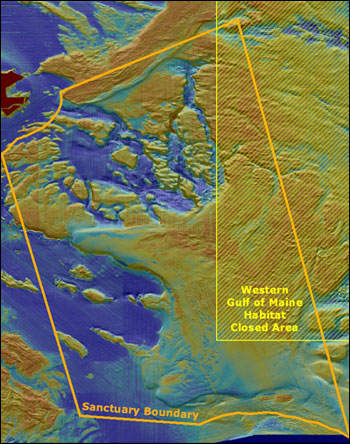 |
| The Western Gulf of Maine habitat closed area was created by NOAA National Marine Fisheries Service and the New England Fishery Management Council in 1998 to aid in the recovery of groundfish. It overlaps 22% of the sanctuary and serves as a de facto reference area. (Source: NOAA/Stellwagen Bank sanctuary)
|
|
|
Due to the large number of threatened and endangered species, and the increasing pressures of human activity in and around the sanctuary, marine mammals are of special interest. Three critical issues have been identified and will be addressed in the Stellwagen Bank National Marine Sanctuary Management Plan: marine mammal vessel strikes, marine mammal behavioral disturbances, and marine mammal entanglements.
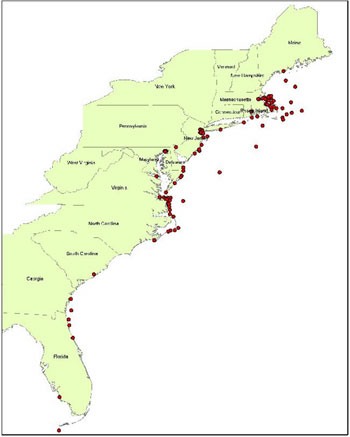 |
| The approximate locations of ship strikes to baleen whales along the eastern seaboard of the US from 1979-2002. Note the high occurrence in and around the sanctuary. (Positions inferred from Jensen and Silber 2003.)
|
|
|
Marine Mammal Vessel Strikes
NOAA and the members of the commercial shipping industry currently disagree over the sanctuary's authority to regulate commercial shipping activities. NOAA asserts that the National Marine Sanctuaries Act provides broad powers to manage commercial shipping, while industry believes that their activities are outside of the sanctuary's purview.
NOAA's objective for addressing the issue of vessel strikes is to determine where and when the potential of collision with marine mammals exists within the sanctuary, to determine what mitigation measures might be necessary and appropriate to minimize that potential and, if necessary, determine what steps might be taken to assess the potential of collision where insufficient information currently exists. Additional objectives are to foster cooperation with cross-jurisdictional partners addressing the issues, and educate sanctuary users regarding the issues.
NOAA staff will work in partnership with various agencies, industries and organizations to address the issue of vessel strikes to marine mammals. NOAA and the U.S. Coast Guard recommended moving the current Boston shipping lanes to reduce the risk of ship strikes to whales. The change was approved by the International Maritime Organization in December 2006. Primary actions that have been recommended by the sanctuary advisory council are:
- Management of commercial ships to reduce the risk of vessel strikes by large commercial ships with right whales and other baleen whales. At a minimum, voluntary speed restrictions should be instituted for large commercial ships to mitigate vessel strikes to marine mammals.
Management of other vessels not actively engaged in approaching whales for viewing. Voluntary speed restrictions should be instituted for vessels other than large commercial ships to mitigate vessel strikes to marine mammals.
Management of vessels actively engaged in approaching whales for viewing. The sanctuary proposes to seek ways to increase compliance with the current whale watching guidelines established for the northeast region of the United States.
Marine Mammal Behavioral Disturbance
There are numerous ways in which marine mammals are potentially disturbed by human activities in the sanctuary. These include activities associated with vessels, aircraft flying over the sanctuary, fishing activities, and other noise disturbances in the vicinity.
Guidelines exist that are intended to reduce these disturbances (e.g., NOAA's National Marine Fisheries Service whale watch guidelines). Underlying these guidelines is the Marine Mammal Protection Act, which federally protects all whales, dolphins and porpoises in U.S. waters. Most large whales are further protected under the Endangered Species Act, including North Atlantic right, humpback, fin, sei, and blue whales.
As there is limited protection from human disturbance of marine mammals in the vicinity of Stellwagen Bank, the sanctuary advisory council has proposed several actions:
- Develop regulations governing the operation of vessels in the vicinity of whales, porpoises, and dolphins. This action includes enforcement, education, outreach, and research.
- Sponsor a consortium to examine and promulgate research on noise in and around the sanctuary and determine its effects on marine life.
- Include the recreational and commercial fishing communities in the development of education materials regarding precautionary operation of vessels around whales.
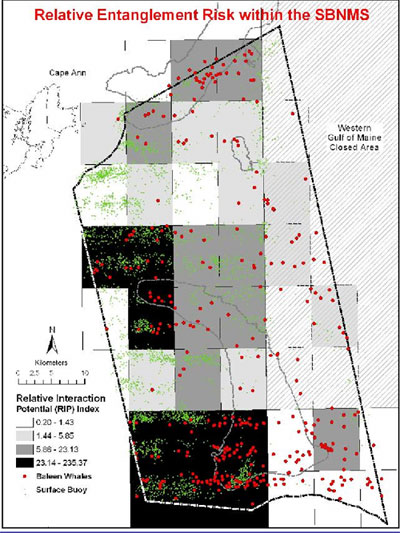 |
| This map indicates high risk areas for whale entanglement based on co-occurrence of whales (red dots) and fixed fishing gear (green dots). (Source: NOAA/Stellwagen Bank sanctuary)
|
|
|
Marine Mammal Entanglement
Marine mammal entanglement in fishing gear is a global problem that impacts many species. Relative to other areas, entanglement reports in Stellwagen Bank are frequent, which could reflect an increased rate of entanglement, increased observer effort, or both. There is frequent co-occurrence between various marine mammal species and types of fishing gears; however, such co-occurrence varies on a spatial and temporal basis.
A number of existing regulations and plans designed to reduce the risk of marine mammal entanglement in the Northeast apply to, but are not specific to, Stellwagen Bank sanctuary. Regulations that are most applicable to marine mammal entanglement within the sanctuary are those pertaining to trap/pot fisheries and gillnet fisheries. Examples are:
- Federal lobster trap limits
Lobster trap gear identification
Lobster trap maximum size
Trap/pot gear restrictions
Lobster trap gear configuration
Special restrictions on critical habitat areas
Restrictions on anchored gillnet gear
Multispecies sink gillnet regulations (aimed at rebuilding overfished groundfish stocks)
Seasonal and rolling closure areas
Gear stowage requirements
Continuing reports of entangled marine mammals, despite federal and state regulations, are of concern. The sanctuary advisory council has recommended four strategies to address the issue:
- Work in partnership with various agencies, industries, and organizations identifying, reporting, and responding to entangled whales to increase the degree to which entangled whales within the sanctuary are sighted, reported, and assisted.
- Work toward a regulation enforcing the use of sinking groundline within the sanctuary within five years, or comply with NOAA's National Marine Fisheries Service regulations (whichever is more stringent). It is also recommended that the breaking strength of buoy weak links in trap and pot gear throughout the sanctuary be 600 pounds.
- Act on an expedited basis to require gillnet fisheries to implement gillnet modifications under the Seasonal Area Management Program. (The program is designed to protect seasonal, predictable aggregations of right whales.)
- Secure a NOAA vessel for permanent duty at the sanctuary to provide a regular presence and team with other state and federal agencies to achieve the desired coverage. The vessel should be equipped to haul gear to check for compliance with state and federal regulations.
The National Marine Sanctuaries Act requires each sanctuary to inventory and document its maritime archaeological resources.
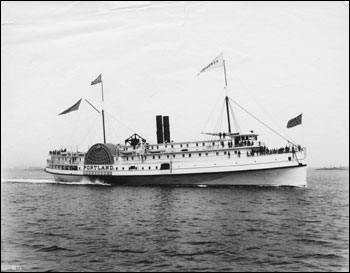 |
| The Portland steaming out of Boston Harbor during its first visit to the city. (Source: Maine Maritime Museum)
|
|
|
Given the existence of historically important shipwrecks in the Stellwagen Bank sanctuary, the likelihood of finding more, and the keen public interest in these resources, it is incumbent upon the sanctuary to continue its effort to inventory and document maritime archaeological resources. NOAA has been charged with protecting and managing maritime archaeological resources within its marine sanctuaries. The National Marine Sanctuary Program regulations mandate that NOAA abide by laws and regulations of the Federal Archaeological Program. These include developing archaeological resource inventory and management programs, overseeing federal activities that may affect historic and cultural resources, and nominating potentially eligible sites to the National Register of Historic Places.
Currently there are three sanctuary specific regulations that pertain to the protection of archaeological resources within Stellwagen Bank sanctuary. Prohibited or otherwise regulated activities are:
- Drilling into, dredging or otherwise altering the seabed of the sanctuary; or constructing, placing or abandoning any structure, material or other matter on the seabed of the sanctuary, except as an incidental result of: (1) Anchoring of vessels; (2) Traditional fishing operations; or (3) Installation of navigational aids.
- Moving, removing or injuring, or attempting to move, remove or injure, a sanctuary historical resource. This prohibition does not apply to moving, removing or injury resulting incidentally from traditional fishing operations.
- Possessing within the sanctuary (regardless of where taken, moved or removed from), except as necessary for valid law enforcement purposes, any historic resource, or any marine mammal, marine reptile or seabird taken in violation of the Marine Mammal Protection Act, Endangered Species Act or Migratory Bird Treaty Act.
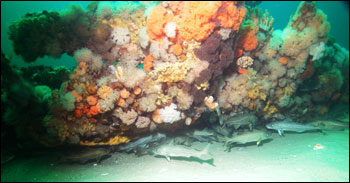 |
| Cod congregate under a portion of the Paul Palmer shipwreck in the sanctuary. (Photo: Tane Casserley, NOAA Maritime Heritage Program)
|
|
|
The sanctuary advisory council has recommended strategies to address the further protection and inventory of Stellwagen Bank sanctuary's maritime archaeological resources. The following four items highlight each of these strategies:
- Develop the foundation and infrastructure for a maritime heritage program at Stellwagen Bank sanctuary, including a full time maritime/marine archaeologist on staff and the familiarization of all sanctuary staff with the maritime heritage program. The sanctuary will also integrate the maritime heritage program into existing natural resource protection programs.
- Develop and implement a systematic plan for the inventory and assessment of archaeological resources.
- Create and implement a maritime heritage management system to protect the archaeological resources while allowing for compatible uses.
- Assess existing sanctuary outreach programs and incorporate the maritime heritage program information into already established programs, such as: (1) sanctuary website (with links to and from other websites); (2) trade show booth; (3) annual publications (Banknotes, Soundings, State of the Sanctuary); (4) workshops.
Error processing SSI file
|

